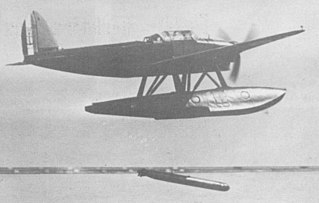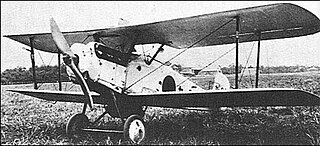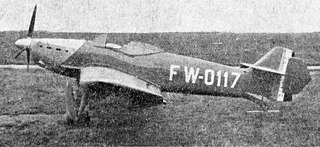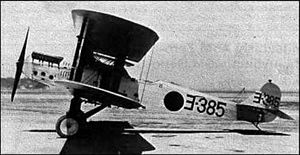
The Dewoitine D.500 was an all-metal, open-cockpit, fixed-undercarriage monoplane fighter aircraft designed and produced by French aircraft manufacturer Dewoitine.

The Aichi B7A Ryusei was a large and powerful carrier-borne torpedo-dive bomber produced by Aichi Kokuki for the Imperial Japanese Navy Air Service during the Second World War. Built in only small numbers and deprived of the aircraft carriers it was intended to operate from, the type had little chance to distinguish itself in combat before the war ended in August 1945.

The Nakajima B6N Tenzan was the Imperial Japanese Navy's standard carrier-borne torpedo bomber during the final years of World War II and the successor to the B5N "Kate". Due to its protracted development, a shortage of experienced pilots and the United States Navy's achievement of air superiority by the time of its introduction, the B6N was never able to fully demonstrate its combat potential.

The Mitsubishi B5M was an Imperial Japanese Navy Air Service (IJNAS) land-based attack aircraft, originally intended for aircraft carrier use. The B5M was also given the long formal designation Navy Type 97 Mk.2 Carrier Attack Bomber and Allied reporting name of Mabel. This aircraft was mistakenly known as the Nakajima Army 97 by the British.

The Nakajima A1N, or Navy Type 3 Carrier Fighter, was a Japanese carrier-based fighter of the late-1920s and early-1930s. It was a licensed copy of the British Gloster Gambet fighter, built by the Nakajima Aircraft Company for the Imperial Japanese Navy. Approximately 150 were built in two versions, the A1N1 and A1N2.

The Latécoère 298 was a French seaplane that served during World War II. It was designed primarily as a torpedo bomber, but served also as a dive bomber against land and naval targets, and as a maritime reconnaissance aircraft. Of a sturdy and reliable construction and possessing good manoeuvrability, it was France's most successful military seaplane, and served throughout the war in various guises.

The Yokosuka B4Y was a carrier-borne torpedo bomber used by the Imperial Japanese Navy Air Service from 1936 to 1943. The B4Y replaced the Mitsubishi B2M2 and the Yokosuka B3Y, and was the last biplane bomber used operationally by the Imperial Japanese Navy. The Allied reporting name was "Jean". This aircraft was mistakenly identified by the British as the Nakajima Navy G-96.

The Mitsubishi B2M was a Japanese carrier-based torpedo bomber of the 1920s and 1930s. It was built by Mitsubishi to a design by Blackburn Aircraft of Britain and was operated by the Imperial Japanese Navy.

The Mitsubishi 1MF was a Japanese carrier fighter aircraft of the 1920s. Designed for the Mitsubishi Aircraft Company by the British aircraft designer Herbert Smith, the 1MF, also known as the Navy Type 10 Carrier Fighter was operated by the Imperial Japanese Navy from 1923 to 1930.

The Mitsubishi 2MR was a Japanese carrier-based reconnaissance aircraft of the 1920s, also known as the Navy Type 10 Carrier Reconnaissance Aircraft or the C1M in the Navy's short designation scheme. Designed for Mitsubishi by the British aircraft designer Herbert Smith, the 2MR was used by the Imperial Japanese Navy through the 1920s and 1930s.

The Loire-Nieuport LN.40 aircraft were a family of French naval dive-bombers for the Aeronavale in the late 1930s, which saw service during World War II.

The Kugisho B3Y, or Navy Type 92 Carrier Attack Bomber, also popularly titled Yokosuka B3Y, was a Japanese carrier-based torpedo bomber of the 1930s. It was designed by the Naval Air Technical Arsenal at Yokosuka, and while unimpressive during testing, it was ordered into service by the Imperial Japanese Navy and used until replaced by more capable aircraft.

The Mitsubishi K3M was a trainer built by Mitsubishi which was used by the Imperial Japanese Navy in an extremely wide variety of roles, including light transport, liaison aircraft, utility aircraft, and occasionally light bomber. Its Allied reporting name was Pine.

The Mitsubishi 1MT was a Japanese single-seat triplane torpedo bomber built by Mitsubishi for the Imperial Japanese Navy Air Service. Designed by the former Sopwith designer Herbert Smith, it was intended for use aboard the Japanese aircraft carrier Hōshō.

The Junkers K 47 was a two-seater fighter aircraft developed in Sweden by the Swedish subsidiary of the German firm Junkers during the late 1920s, a civil development of which was designated the A 48.

The Mitsubishi 2MB1 was a light bomber produced in Japan in the mid-1920s to equip the Imperial Japanese Army.
The Nakajima B3N was a prototype Japanese carrier-based torpedo-bomber aircraft of the 1930s. A single-engined biplane with a crew of three, it was unsuccessful, only two being built.

The Mitsubishi 3MT5 was a Japanese bomber of the 1930s. It was a twin-engined biplane that was intended to operate from Japanese aircraft carriers, but proved to be unsuitable for carrier use, and the eleven aircraft built were instead used as land-based trainers.

The Mitsubishi 2MB2 or Experimental Washi-type Light Bomber was a prototype Japanese single-engined biplane light bomber of the 1920s. A single example was built for the Imperial Japanese Army, but no production followed.

The Mitsubishi Ka-12 or B4M was a Japanese carrier-based torpedo bomber of 1934. Two prototypes were built by Mitsubishi for the Imperial Japanese Navy. A development of the company's 3MT10 of 1932, the design differed primarily in the use of a radial engine and metal wing, which made the whole aircraft significantly lighter and faster. However, the design could not realise its potential as the wing was inefficiently stiff and the B4M was not selected for production. The competing Yokosuka B4Y was chosen to serve on the Navy's aircraft carriers instead.





















